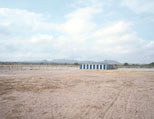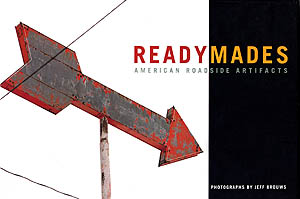|
Master of the Vernacular
What is it that makes stuff art? Ever since Marcel Duchamp and his readymades, it's been an artist saying something is art. In a genre like outsider art, it's more likely to be recognition by a collector, curator or dealer that defines an object as art, since the classic artists brut by definition are unwilling or unable to aspire to that label. Jeff Brouws is a specialist in declarations of art, although in his case it's not pictures by the untaught or Duchamp's prosaic manufactured objects that are being accredited, but readymades in the landscape. His photographs, which are works of art in their own right, transform house trailers, boxcars, tract homes and other case studies in the inarticulate and plain unexpressive. This new book of photos is a triumph of the collector's eye, a collection of found objects on a grand scale. Brouws captures the appeal of his project succinctly in one of his essays. "Everything in the world is interesting, mystifying, individual, and worthy of our attention, no matter how banal or ordinary." Personally I think he's right, that is actually a matter of opinion, or at least taste; many people find the banal, well, banal. But there is a strong case to be made for Brouws' assertion. Finding something of interest in the chaos and drone of everyday life helps make every day that much more interesting. This can involve the thrill of discovering a quality of form or meaning that is inherent but not immediately visible. Or it can be more a matter of projecting meaning, synthesizing what is aesthetically compelling from a haphazard confluence of materials or vistas. Brouws credits Ed Ruscha and his 1962 book Twentysix Gas Stations for sparking his interest in "the unique qualities of similar objects," but the influence of the German photographers Bernd and Hilla Becher also eems quite explicit. Brouws' grids of decaying boxcars and pickup trucks clearly echo the Becher's typologies of blast furnaces, coal mine tipples and other industrial artifacts. Like the Bechers, Brouws captures the poignancy of the ordinary without sentimentalizing it, while at the same time uncovering its formal beauty -- the most unique of its unique qualities. But where the Becher's specialty is decaying industry, Brouws is specifically a master interpreter of vernacular culture, abandoned or thriving. He faces some real challenges, since most of what is said in the vernacular (which accounts for most of what is said in the world) is no more inherently interesting than anything else. And despite a school of thought that sometimes says otherwise, there is no mystical quality or moral superiority arising from the mere fact of commonness. What can set vernacular objects apart, however, is age. The older and more weathered the subject, the easier it is, even for amateurs, to draw out something appealing. Why? Because as the original context disappears, an artifact's inherent qualities stand out more and more, the way an eroding bit of rock can reveal a gemstone within. In the specific case of roadside vernacular, the disappearance of similar signs and buildings pulls survivors out of a background that was not merely visual. The near-universal disdain these relics sparked in their time had to pass before they could become beloved, or even particularly visible. The idea of Route 66 tourist kitsch as poignant or attractive would have been laughable to the parents driving it in 1960 with a station wagon full of screaming kids. But now, what was entirely ordinary or worse eventually becomes a channel to a disappearing world, interesting because the culture it reveals has otherwise passed away. The speck of a legacy is valued all the more as the heart of the legacy vanishes. Brouws' interest in that legacy is by no means unique. A soft touch for the retro bowling alley or drive-in theater, he covers ground familiar to aficionados of old highways, neon signs and the vernacular landscape in general. But his eye performs equally well whether he is documenting now-treasured vintage neon or re-envisioning what is still universally ignored, like, say, self-storage facilities. A disciplined aesthetic sensibility takes his photos far beyond nostalgia for a disappearing landscape. Effectively, he creates an important new readymade everywhere his photographic gaze falls. A version of this review originally appeared in The Outsider magazine, published by Intuit: The Center for Intuitive and Outsider Art. |
|
|

|
|
|

|
| Or check out my documentation of roadside vernacular, from gyros signs to mansard roofs. |
 
|
